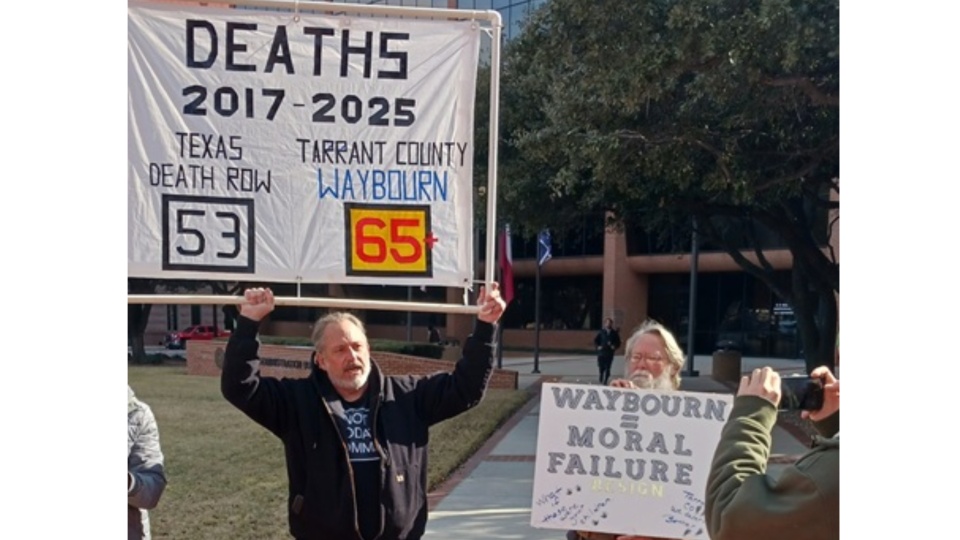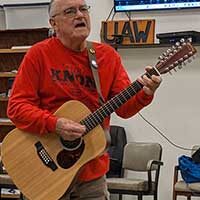
The Fort Worth Star-Telegram recently revealed that investigating doctors had ruled that Kimberly Phillips was starved to death in the Tarrant County Jail. Apparently, they served her regular jail food over her protests about her dietary problem. They booked her on Jan. 25, took her to the county hospital on Feb. 15, and she died on Feb. 18.
In the same period, Charles Stephen Johnson died in custody on Feb. 8. They said he died from “complications” due to a suicide attempt. For unexplained reasons, the Sheriff’s Department did not report the death within the 30 days required by Texas law.
Since the election of Sheriff Bill Waybourn in 2017, there have been 65 inmate deaths in Tarrant County Jail – more than Harris County Jail (Houston), which deals with more than twice as many inmates. In fact, more people have died in the Tarrant County Jail than on Texas Death Row since 2017, where 53 have been executed. Most of the dead in Tarrant County were not convicted of a crime; they just couldn’t afford bail while awaiting trial.
Along with other North Texans, I have been protesting the deadliest jail in Texas. I was outside in a misty rain on Jan. 3. Mason Yancy had died in custody on Dec. 27 after being arrested in Grapevine, Texas, on Christmas Eve for possession of narcotics and drug paraphernalia. He informed the county hospital staff and the jailers that he was diabetic and needed medication. He was scheduled for a medical and mental health exam and put in detox. A week later, he was dead.
Outside the jail, we chanted “No justice, no peace.” As the doors opened during the deputy shift change, we could hear the chants echoing back from inside: “No justice, no peace!”
I decided to attend the next Commissioners Court on Jan. 14. As I walked toward the court, I could see the protesters and police cars outside. Inside, the place was packed, and the overflow area was standing-room only.
Most of the attendees were family and friends of the victims. Darren Yancy testified that his brother called him the day before his death saying he would not survive another day inside. He didn’t.
Things started to get hot when Sheriff Waybourn came to the podium. He claimed that Mason Yancy got the best health care available and had two nurses with him when he passed away. That’s when the crowd got loud! The sheriff kept referring to inmates as “these people” and said Mason Yancy was on ketamine at the time of his arrest, but this was never proven.
Things got out of hand at the Commissioners Court. Presiding Judge Tim O’Hare began to clear the courtroom. The crowd moved in tight around the deputies, and O’Hare continued calling for removals.
Citizens with phones in hand began asking deputies for names and badge numbers. The deputies did not comply and continued to remove citizens. In the end, one man was arrested for having a legal firearm. Two others were detained and then, finally, released.
Back in 2017, Texas enacted Senate Bill 149, “The Sandra Bland Act.” This law requires any in-custody death to be investigated by an outside law enforcement agency. To this day, no one has investigated deaths in Tarrant County Jail except Tarrant County Sheriffs. Meanwhile, the body count grows.
The jail has a history
The Tarrant County Jail is notorious. It was constructed so poorly that, when it opened in 1877, over 600 inmates escaped by removing bolts from doors with their fingers. Escapes were so common that local newspapers didn’t bother reporting them.
In 1883, the Tarrant County Commissioners Court approved $50,000 for a new jail, which was completed in 1894. The jail was used for executions until 1918, and eight lives were ended there by court order.
The jail continued to be known for escapes, as well as suicides. Twice, the jail was attacked by Fort Worth citizens attempting to lynch inmates. In the 1930s, deputies may have been ignoring their jail duties because they were performing so many evictions.
In 1933, there were over 6,000 unemployed workers in Fort Worth. The Governor of Texas, Miriam Ferguson, suspended relief to the unemployed. A 40-year-old Communist, Terrence Earl Barlow, who had just run as a write-on candidate for Lieutenant Governor, came to Fort Worth to organize a chapter of the Unemployed Council. He was to meet his fate in the Tarrant County Jail.
Barlow’s main objective was to keep families from being evicted. The Unemployed Council would protect a family’s belongings when they were thrown in the street. Then, at first chance, they would move the furnishings back into the home. The landlord would then have to go through the process of applying for a new eviction order.
In July 1933, Barlow and 29 others were arrested for these activities. He told the Fort Worth media that he didn’t mind being in jail because at least he had food and a roof over his head, though he did say he’d rather be free to help stop more evictions.
Barlow and two others were arrested again in August right after sending a telegram to Gov. Ferguson protesting the cuts to the unemployed. They were arrested outside the Western Union office for illegal assembly and taken to jail, where guards watched Barlow being assaulted by another inmate.
The next morning, Terrence Barlow’s bond was set at $1. Soon after lockdown at 4:30 a.m., other inmates heard a thudding sound from Barlow’s cell. The jail doctor took him to the hospital where he was pronounced dead. The county examiner said the cause of death was a blood clot caused by a one-inch crack to the skull, possibly from the beating of the previous day. At a hearing, the coroner testified that Barlow’s skull was unusually thin “for a white man.”
Barlow’s friends and relatives did not believe the official report (which was destroyed in a purge of county records), so they paid for their own exam. This exam found signs of torture and beatings. He even had electrical burns. His funeral was held on Labor Day 1933, with over 1,000 people in attendance.
My history with Tarrant County Jail
My own history with the Tarrant County Jail goes back to 1974. A friend and I were walking home from Veterans Park in Arlington, near Fort Worth, when a bright light hit our eyes. It was a police car. The officer conducted an illegal search of both of us and found a plastic baggie in my pocket. It had a few cannabis seeds. I was arrested, and my friend was arrested for having no identification.
I guess I was lucky. The same charge would have been a felony less than a year earlier. As it was, I was looking at six months in the Tarrant Clounty Jail, and I was only 17.
The cop was brutal. He carried me by my handcuffs. My feet didn’t touch the floor. He threw me down on a concrete floor, picked me up again, and pushed me into a wall to take the cuffs off. Another cop said the seeds weren’t enough to charge me, so the arresting officer added what looked like a quarter ounce to my evidence envelope. My friend was being held, too, but not charged.

Arlington jail likes to send people to Tarrant County Jail after 10:30 p.m. That way, you can’t be bonded out for at least one day. Everybody gets to experience Tarrant County Jail for at least one night; I was there four nights.
I was sprayed with what smelled like kerosene and taken to the ninth floor. The ninth floor at that time was where prisoners being transferred were held—real criminals, bound for state prison.
As soon as I walked on the floor, I was introduced to a Tarrant County Jail tradition called “chest boxing.” Much like T.E. Barlow, I had to fight upon arrival. I was told that usually you just punch the chest, but in my case, they would go for my face. I punched first and broke the nose of the inmate doing the talking. After that, I was hit and kicked by everyone on the floor. I rolled up in a ball and tried to protect my head. They beat me until lockdown.
The next morning, I was taken for my arraignment, and bond was set. Sheriff’s deputies asked about my injuries, and I explained the game of “chest boxing.” I blamed no one for my injuries. When they took me back to the ninth floor, everyone expected deputies to be with me. When they realized I hadn’t talked about the beating, they backed off. Only the Sunday morning preacher got the whole story.
I did not eat in jail. I drank the coffee in the morning, but that was it. The food looked horrible. My brother and girlfriend bonded me out two days later. My friend in Arlington jail was incarcerated longer than me, just for not having identification. He fell from a bunk and got a concussion. After that, they released him. He had actually passed out from the heat.
Thinking back, we’re both lucky to have survived sheriff’s custody in Tarrant County, Texas. Many people don’t.
We hope you appreciated this article. At People’s World, we believe news and information should be free and accessible to all, but we need your help. Our journalism is free of corporate influence and paywalls because we are totally reader-supported. Only you, our readers and supporters, make this possible. If you enjoy reading People’s World and the stories we bring you, please support our work by donating or becoming a monthly sustainer today. Thank you!











